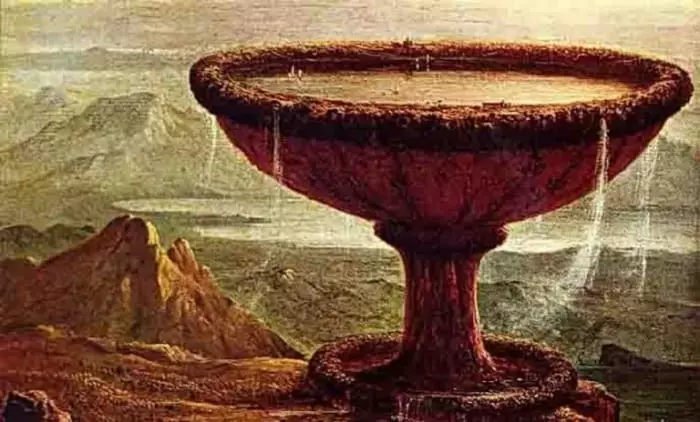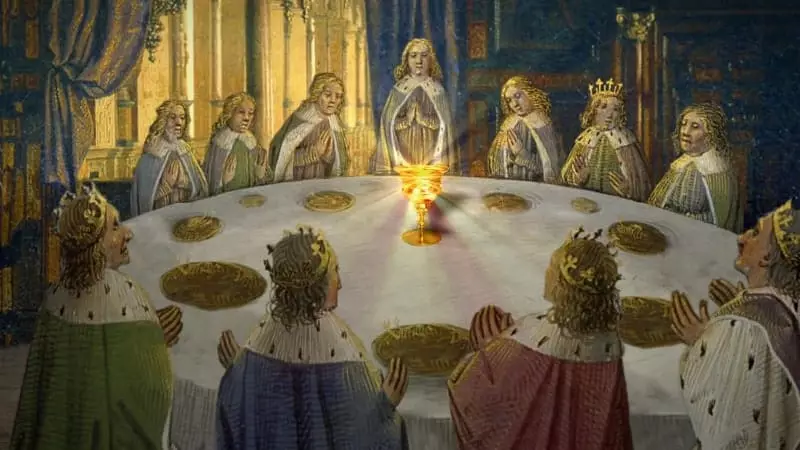The search for the Holy Grail have lasted for many centuries. Mystic vessel identifyed to Gentile cornucopia, associated with the Last Supper as a receptacle for participle called stone daruyuschim immortality. Grail - what is it?
From the Last Supper to Mansalvata
Sacred bowl wrapped many centuries the mysterious veil. We only know that it is a powerful relic bestows many creature comforts. It is associated with the first chalice, to serve Jesus Christ and his apostles, when held the Last Supper.
Some legends say that the Grail - it's agate, adorns the crown of Lucifer, lost them during the overthrow of the sky.
Find out what awaits you today - a horoscope for today for all zodiac signs
In another legend about the cup it is said that during the execution of the Son of God it has been collected blood flowing on the crucified body. I did Joseph of Arimathea, who was Jewish elders and secret follower of Christ.

Angry act of Joseph Jews throw him in jail and forget about it. Sacred vessel supported the unfortunate prisoner for forty-two years, giving him food and letting die of hunger and thirst. Joseph was released by Emperor Vespasian, who was cured of leprosy by means of the shroud with the face of Christ. From that moment, wandering holy vessel.
Joseph of Arimathea was a vision in which Jesus instructed him to preserve the sacred chalice. He hides in the things of the Grail, and sent him to the shores of Britain. Before his death, Joseph entrusts the care of the Grail to his nephew.
By numerous requests of readers, we have prepared an application "Orthodox calendar" for a smartphone. Every morning you will receive information about the current day: Holidays, posts, commemoration days, prayers, parables.
Download free: Orthodox calendar 2020 (Available on Android)
Another legend tells that the sacred vessel for a long time was in heaven, waiting for the time when the Earth will be worthy knights.
The ancestor of those who had the privilege to keep the famous relic becomes the ruler of Asia - Perillo, who settled in Gaul. Later, his heirs will create marriages with children of the influential Prince.
Protect the sacred vessel of the pious Titurel charge, a descendant of Perilla. It was he and his loyal knights are called to protect the heavenly bowl, in the name of which they erected the castle Monsalvat. The legend says that the cup is still under the arches of the legendary castle.
In numerous legends it is described that the sacred Grail gave food and drink to all those who wondered him and worshiped him. He also healed incurable diseases, could give immortality and eternal youth. The mysterious vessel gave enlightenment and mental purity to all those who touched it. Already many centuries to the grain include both the most legendary and mysterious relics in the history of mankind.
How the legend was born
The legend of the mysterious cup has long been considered "people's", and track the beginning of the birth of the legend is quite difficult. However, people who are engaged in learning everything that is associated with the mystical Cup does not lose hope. They claim to start the search need in medieval Europe. It is there that at that time expands a large-scale search of Christian relics.At that time, the Roman Church obliges all the temples to keep the remains or things of the saints. Reliquia things are transferred to the category of goods that make considerable benefits. From the eastern countries to European states begin to bring the great many of the relics, bones and items, allegedly owned by the famous saints.
The most appreciated those relics that were related to the passions of Christ. These were:
- parts of the wooden cross on which crucified Christ;
- Longin's spear;
- nails who nailed Jesus to the cross;
- Small shroud with the face of the Son of God and big with a print of his body;
- Ternist crown.
All this wanted to get into their property large feudalles, high-ranking church ministers and even the monarchs.
Lack of bowl
However, among many of the sacred things inserted by the clergy for review in the temples, there was no legendary cup of gravel. Its value for servants of the Church is impossible to overestimate. After all, according to the legend, Christ is the first time he ordered his followers during a secret evening. Considering this fact and the importance that the verdict of wine in the Catholic Church was attached, such a vessel became the most desirable relic.
The absence of such an important subject in the clergy was obvious. Various assumptions were built, rumors were spreading about the location of the powerful raritet and its unusual properties.
At that time, the french kings dynasty was able to collect a huge number of Christian shrines. In contrast to such "success", Britain puts forward a legend about the sacred vessel and argues that he is in its territory.
The right to such an approval of Britain receives after a manuscript that tells about the graveyard was discovered. These were two ancient documents, "revealing" mystery.
Chronicle of William Malmsbury and Manuscript Grand Saint Graal
The chronicle tells about the distant 63 years from the Nativity of Christ. At that time, the Christian faith of the faithful followers of the Apostle Philip arrive in Britain. Preachers headed by Joseph from Arimafia erect the first Christian temple on the place where the Glastonbury abbey will be founded over time. Legends say that it is in this abbey that the body of the famous King Arthur and Queen Guinera will find. Before this day there is a source, which is called "bowl of the bowl."Another manuscript includes a manuscript dated by the XII century. It is discussed about the delivery of the sacred grail in Britain and knights - the keepers of the bowl. This story was reproduced in their novels Robert de Brooron and Kreten de Troa, having rinked his story with the legends about the fearless king Arthur.
The British "version" of the appearance on its expanses of an invaluable relics acquires unprecedented popularity and becomes almost the "medieval bestseller". Many European countries appear to similar stories and novels that tell new "reliable" details. So the legend applies and becomes a "historical fact", causing more and more interest among many nations of the world.
Priming grail
There is another version, why it is in Britain a legend of a graveyard as a vessel that can give abundance and other benefits. The relationship between the Christian gravity and the pagan prototypes, also giving food, health, gold and knowledge. Here are just a few examples.
- In Ireland, the Dagda boiler, from which cameras and drinks appeared in such mystical properties.
- In Britain, a magic bowl, brought by powerful Merlin on a crystal ship, was considered such a horn of abundance. This piece could show the future, open the sacred knowledge and secrets of the universe.
- Welsh Mythology talks about a vessel of wisdom belonging to the goddess seried. He is talking about the "History of Taleesign".
- Also in Wallian legends and legends mentioned another magical thicket, which was presented by Brune Blessed Dwarf from Lake Bowl, Witch and Black Giant. This vessel healed any fatal disease, heal wounds and resurrected the dead. In the legend about Brane, it is said that later the bowl loses its abilities. During the battle, Bran blessed throws a sliced head of his enemy into her, than settles the purity of the vessel.
All these legends may have formed a majority of the gravity bowl.
Bowl, dish and stone
The sacred grail is associated not only with the image of the bowl. This is just one image of a variety of others. In some Welsh legends, the Grail is rejected with a silver dish, on which a bloody head is lying. This image remotely resembles a story with John the Baptist.Eschenbach in Parcifalek describes the gravity as a stone with unique magic properties and capable of doing wonders. According to some versions, the Grail is a receptacle for Christ, and this is Mary's Virgin. Over time, the number of assumptions and versions only grew, and there was no single idea of such an amazing relic.
Name
The mystery and name of the sacred vessel remains. Why did this bowl given such a name? The answer cannot be found in any confirmed historical document or legend. Therefore, the origin of the word "Grail" remains unknown and generates many theories and guesses.

According to one version, it is believed that the name and associated legend have Celtic origin. Such an approval is based on the consonance of the name of the famous Bowl and the Irish word Cryol, which means "Basket of Abundance". Here matches the sense load of the word and the magical properties that are attributed to the grain bowl.
Another version reveals the meaning of the Starofranzus word "Sangreal", which is translated as "true blood". Another version comes from the word "Gratalem", denoting a large vessel in which wine and water mixes.
Search for Holy Grail
Even today, new "candidates" on the title of Holy Grail are put forward. So, in 2014, in Leon Basilica, they found an ancient relic, which was immediately called the Graa. Historians who opened it claim that after the crucifixion of Jesus Christ, the sacred vessel was transported to Palestine. Then he is "declared" in Egypt, and already from there falls into the Arab Spain. After the liberation of Spanish lands from Arabs, the Grail moves to the city of Leon. There it is numbered by the Crank bowl in honor of Queen Castilskaya.
Nowadays, several cities are at once trying to prove that they have an ancient mysterious relic. The most famous "challengers" can be counted the silver vessel - the Antioch Patir. It was discovered antiquary in Antioch at the beginning of the last century. The vessel is made in the form of a cup on a round leg. It relumously shows Jesus Christ and his apostles.
Another "unique genuine" Grail is in Valencia and belongs to the Cathedral of St. Mary.
Read more about the sacred relics here:
